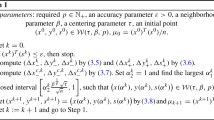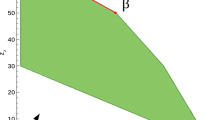Abstract
Multistage stochastic linear programming (MSLP) is a powerful tool for making decisions under uncertainty. A deterministic equivalent problem of MSLP is a large-scale linear program with nonanticipativity constraints. Recently developed infeasible interior point methods are used to solve the resulting linear program. Technical problems arising from this approach include rank reduction and computation of search directions. The sparsity of the nonanticipativity constraints and the special structure of the problem are exploited by the interior point method. Preliminary numerical results are reported. The study shows that, by combining the infeasible interior point methods and specific decomposition techniques, it is possible to greatly improve the computability of multistage stochastic linear programs.
Similar content being viewed by others
References
Ariyawansa, K.A. and Hudson, D.D. (1991), Performance of a benchmark parallel implementation of the Van Slyke and Wets algorithm for two-stage stochastic programs on the Sequent/Balance, Concurrency Practice and Experience, 3, 109–128.
Bahn, O., du Merle, O., Goffin, J.-L. and Vial, J.P., (1995), A cutting plane method from analytic centers for stochastic programming, Math. Program., 69, 45–73.
Berkelaar, A., Dert, C., Oldenkamp, B. and Zhang, S. (2002), A primal-dual decomposition-based interior point approach to two-stage stochastic linear programming, Oper. Res., 50, 904–915.
Berkelaar, A., Kouwenberg, R. and Zhang, S. (2000), A primal-dual decomposition algorithm for multistage stochastic convex programming, Tech. Report SEEM2000-07, The Chinese University of Hong Kong.
Birge, J.R. (1995), Current trends in stochastic programming computation and applications, Tech. Report 95-15, Department of Industrial and Operations Engineering, University of Michigan.
Birge, J.R. and Holmes, D.F. (1992), Efficient solutions of two-stage stochastic linear programs using interior point methods, Computational Optim. Appl., 1, 245–276.
Birge, J.R. and Louveaux, F. (1997), Introduction to Stochastic Programming, Springer, Berlin.
Birge, J.R. and Qi, L. (1988), Computing block-angular Karmarkar projections with applications to stochastic programming, Management Science, 34, 1472–1479.
Carpenter, T., Lustig, I. and Mulvey, J. (1991), Formolating stochastic programs for interior point methods, Oper. Res., 39, 757–770.
Chun, B.J. (1992), Scenario analysis modeling and decomposition methods, Tech. Report 92-8, Department of Industrial Engineering, University of Wisconsin-Madison.
Chun, B.J. and Robinson, S.M. (1995), Scenario analysis via bandle decomposition, Ann. Oper. Res., 56, 39–63.
Helgason, T. and Wallace, S.W. (1991), Approximate scenario solations in the progressive hedging algorithm, Ann. Oper. Res., 31, 425–444.
Higle, J.L. and Sen, S. (1996), Stochastic Decomposition: a statistical method for large-scale stochastic linear programming, Kluwer Academic Publishers, Dordrecht, The Netherlands.
Kojima, M., Megiddo, N. and Mizuno, S. (1993), A primal-dual infeasible-interior-point algorithrn for linear programming, Math. Program., 61, 263–280.
Lustig, L.J. (1990), Feasibility issues in a primal-dual interior point method for linear programming, Math. Program., 49, 145–162.
Mehrotra, S. (1992), On the implementation of a primal-dual interior point method, SIAM J. Optim., 2, 575–601.
Mizuno, S. (1994), Polynomiality of infeasible interior point algorithms for linear programming, Math. Program., 67 109–119.
Mizuno, S., Kojima, M. and M.J. Todd, (1995), Infeasible-interior-point primal-dual potential reduction algorithms for linear programming, SIAM J. Optim., 5, 52–67.
Mulvey, J.M. and Vladimirous, H. (1991), Applying the progressive hedging algorithm to stochastic generalized networks, Ann. Oper. Res., 31, 399–424.
Rockafellar, R.T. and Wets, R.J-B. (1991), Scenarios and policy aggregation in optimization under uncertainty, Math. Oper. Res., 16, 119–147.
Ruszczyński, A. (1993), Parallel decomposition of multistage stochastic programming problems, Math. Program. 58 201–228.
Ruszczyński, A. (1997), Decomposition methods in stochastic programming, Math. Program., 79, 333–353.
Ruszczyński, A. (1999), Some advances in decomposition methods for stochastic linear programming, Stochastic programming, State of the art, 1998 (Vancouver, BC). Ann. Oper. Res., 85, 153–172.
Sun, J., Wee, K.E. and Zhu, J.S. (1995), An interior point method for solving a class of linearquadratic stochastic programming problems, in: Qi, L. and Womersley, R. (eds.), Recent Advances in Nonsmooth Optimization, World Sci. Publishing, River Edge, NJ, 392–404.
Ye, Y., Todd, M.J. and Mizuno, S. (1994), An O(√L)-iteration homogeneous and self-dual linear programming algorithm, Math. Oper. Res., 19, 53–67.
Ye, Y., Kortanek, K.O., Kaliski, J. and Huang, S. (1993), Near boundary behavior of primal-dual potential reduction algorithms for linear programming, Math. Program., 58, 243–255.
Zhang, S. (in press), A primal-dual interior point and decomposition approach to multi-stage stochastic programming, in: Yao, D.D., Zhang, H. and Zhou, H.Y. (eds.), Stochastic Models and Optimization, Springer, Berlin.
Zhang, Y. (1994), On the convergence of a class of infeasible interior-point methods for the horizontal linear complementarity problem, SIAM J. Optim., 4, 208–227.
Zhao, G.Y. A Lagrangian dual method with self-concordant barrier for multi-stage stochastic convex programming, Working Paper, Dept of Mathematics, National University of Singapore, 1998, revised 2000.
Zhao, G.Y. (2001), A log-barrier method with Benders decomposition for solving two-stage stochastic linear programs, Math. Program., 90, 507–536.
Author information
Authors and Affiliations
Rights and permissions
About this article
Cite this article
Liu, X., Sun, J. A New Decomposition Technique in Solving Multistage Stochastic Linear Programs by Infeasible Interior Point Methods. Journal of Global Optimization 28, 197–215 (2004). https://doi.org/10.1023/B:JOGO.0000015311.63755.01
Issue Date:
DOI: https://doi.org/10.1023/B:JOGO.0000015311.63755.01




